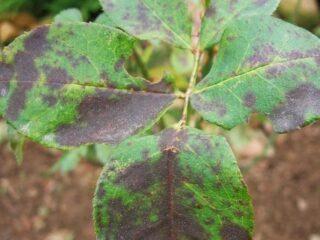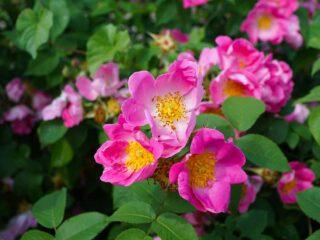Content
- 1 What types and varieties of rose hips are there?
- 1.1 Rose hip (Rosa pimpinellifolia)
- 1.2 Dahurian rose hip (Rosa davurica)
- 1.3 Rosehip (Rosa acicularis)
- 1.4 Dog rose (Rosa canina)
- 1.5 Rosehip (Rosa amblyotis)
- 1.6 French rose hip (Rosa gallica)
- 1.7 Rose hip (Rosa majalis)
- 1.8 Rosehip (Rosa rugosa)
- 1.9 Rosehip (Rosa caesia)
- 1.10 Golden rose hip (Rosa chinensis)
- 2 What varieties of rose hips are the most useful?
- 3 Varieties of large fruit rose hips
- 4 Beautiful varieties of rose hips
- 5 Rosehip varieties without thorns
- 6 Varieties of round rose hips
- 7 The best garden rosehip varieties for the Moscow region
- 8 The best rosehip varieties for the Leningrad region
- 9 The best rosehip varieties for Siberia
- 10 Conclusion
There are dozens of types of rose hips; to choose a plant for your summer cottage, you need to study more options.Some varieties are in demand due to their beautiful flowering, others bear tasty and healthy fruits.
What types and varieties of rose hips are there?
From all the diversity, several types of rose hips can be distinguished. They are the best known and most often found in cultivated cultivation.
Rose hip (Rosa pimpinellifolia)
The femoral rosehip has shoots with red-brown shiny bark and narrow lanceolate leaves. The plant blooms in late spring and early summer, the buds are oval-shaped, white, yellowish or light pink. The berries are oblong, with a velvety-felt surface.

The femoral type of rosehip grows up to 2 m
Dahurian rose hip (Rosa davurica)
The medium-sized shrub blooms in June and July with beautiful dark pink buds with solid edges. The leaves are compound, odd-pinnate, with two curved, protruding spines located at the base of the shoots. The berries of the plant are bright red and spherical in shape.

Daurian rosehip grows 1-2 m above the ground
Rosehip (Rosa acicularis)
A spreading shrub with arched shoots bears single pink or reddish flowers in mid-summer. It has pinnate leaves with thin pubescence at the bottom. Produces red berries that are strongly tapered at the base. Rises up to 2 m above the ground.

The shoots of the needle rose are covered with abundant thin thorns
Dog rose (Rosa canina)
A tall shrub with numerous pink flowers and strong curved shoots. The branches of the plant are covered with sparse, short and sharp thorns. The fruits are orange-red, smooth, oval-shaped, and ripen in August. This species of the Rosehip genus can reach 2.5 m in height.

Dog rose blooms in May and June.
Rosehip (Rosa amblyotis)
A beautiful shrub with dark pink large single buds blooms from June to July. The shoots of the plant are covered with straight awl-shaped thorns, the bark on the branches is black-brown or black-purple. The fruits are small, about 2 cm in diameter, spherical in shape and red in color.

Blunt rosehip is widespread in Siberia and the Far East
French rose hip (Rosa gallica)
A low shrub with splayed or straight shoots produces single flowers on long stalks. The petals of the buds are dark pink; in the fall the species bears fruit - spherical or egg-shaped berries. The culture blooms in June and July.

French rose hips will only grow to 1 m
Rose hip (Rosa majalis)
Among the types of rose hips in the forest and in gardens you can find a shrub that blooms with pale or dark pink-red buds. The berries are small but fleshy, orange or scarlet in color. The shoots of the species are covered with thorns - curved, small in size, located at the base of the leaves. The height of the plant is 1.5-2 m.

May rosehip blooms from late spring to July
Rosehip (Rosa rugosa)
One of the ancient varieties of rose hips was popular hundreds of years ago. Today it is represented by numerous decorative varieties. It rises up to 2 m above the ground, the branches are covered with thin thorns and small needle-shaped spines, the leaves are strongly wrinkled. Produces round and large bright red fruits. The buds of the species are a beautiful dark pink or crimson shade.

Wrinkled rosehip blooms in midsummer and can bloom again in the fall
Rosehip (Rosa caesia)
The species got its name because of the bluish coating on the surface of the shoots and leaves. The thorns of the shrub are curved, widened at the bottom, the plates are pubescent at the bottom. The bright pink buds are usually collected in corymbs, while the sepals are also covered with grayish hairs.

Blue rose hips bloom from June to July
Golden rose hip (Rosa chinensis)
The decorative appearance of the shrub is valued for its beautiful flowering with large yellow buds. It grows up to 2 m, has flexible light brown shoots and oblong leaves. Often used in hedges.

Golden rose hips do not bear berries
What varieties of rose hips are the most useful?
Of particular interest are cultivated varieties that produce tasty and vitamin-rich fruits. Almost all types have benefits, but a few of them stand out.
Vorontsovsky-3
One of the medicinal varieties of rose hips with good taste ripens in an average time and produces about 2 kg of berries per bush. It blooms with pale pink buds and bears small ovoid fruits in small clusters. The berries of the variety contain up to 4400 mg of ascorbic acid, which makes them very valuable for the immune system.

Vorontsovsky-3 has a sweet and sour taste
Rukh
A late-ripening species with pink buds produces elongated orange berries in clusters of two fruits. It is distinguished by its vitamin C content of more than 1020 mg per 100 g. The berries themselves are large, up to 3 g by weight.

Rosehip Rukh requires pollination by related varieties and species
Vitamin VNIVI
A spreading variety of edible rose hips produces large spherical fruits with a sweet and sour taste. From one copy of the plant you can collect up to 3 kg of berries.The pulp contains about 4000 mg of vitamin C, and carotenoids that are beneficial for the body are also present in large quantities.

Vitamin VNIVI can grow in the Urals and Siberia
Varieties of large fruit rose hips
Some of the cultivated varieties are distinguished by particularly large fruits. If you plant such a shrub on your site, you can reap abundant harvests every year.
Large-fruited VNIVI
One of the largest-fruited rosehip varieties is rarely affected by fungi and insects. Produces berries weighing up to 13 g, round and slightly flattened. Harvesting can be done from August to September.

Large-fruited VNIVI blooms from June until cold weather
Spire
The cold-resistant variety bears fairly large fruits, about 4 g in weight, with an elongated shape. The berries are orange in color, contain about 520 mg of vitamin C, and are suitable for preparations and jam. The variety is distinguished by beautiful pink flowering, the buds emit a pleasant aroma.

Rosehip variety Shpil produces about 2 kg of fruit per bush
globe
A medium-sized variety of 1.5 m produces massive fruits weighing over 3.5 g, bright red in color. It is characterized by high frost resistance, good yield and a pleasant sour taste.

Globe fruits are suitable for candied fruits and jams
Rosy
The variety is distinguished by red round berries of 3 g each. It produces good yields and rarely suffers from fungi, but does not tolerate severe frosts. It is better to grow the species in the middle zone.

Berries of the Ruddy variety have a sweetish taste
Oval
This variety, popular among gardeners, is characterized by heavy fruits of 8 g each with thick skin and sweet pulp. It is not afraid of cold weather and does not suffer from diseases; it grows compactly. The average height is 1.5 m.

Rosehip variety Oval blooms with beautiful white buds
Sergei Mironov
The rose hip variety bears oval, flattened fruits up to 12 g. The berries are red in color, with a dense peel. Sergei Mironov is a medicinal variety of rose hips, since the fruits are often used for drying and creating preparations. It tolerates cold well and is not afraid of pests.

The variety Sergei Mironov ripens at the end of August
Beautiful varieties of rose hips
Some varieties are especially valued for their bright and spectacular flowering. They are often used for hedges and artistic compositions in the garden.
Ballerina
An unpretentious ornamental shrub grows well in partial shade and bright sun. It blooms from July to September, the buds are light pink with a faint aroma, up to 3 cm in diameter.

Rosehip variety Ballerina grows up to 1.5 m
Nana
Among the varieties of rose hips with photos of flowers, there is a low shrub with spreading prickly branches. Nana bears beautiful light pink buds that turn white as they wither. The pyramidal scutes reach 3 cm in width and emit a pleasant fruity smell.

The Nana variety grows no higher than 70 cm
Resonanz
Among the types of rose hips with photos, names and descriptions, one can highlight the beautiful Rezonants bush. A variety with bright red semi-double buds grows up to 90 cm above the ground. The main flowering occurs in the summer; with good care, it can bloom again in the fall. It produces red fruits, but is valued for its decorative qualities.

The rose hip variety Rezonants has received numerous international awards.
Rosehip varieties without thorns
Plant species with smooth shoots or sparse and soft thorns are in high demand. It is much more convenient to harvest from such bushes.
Thornless
A tall variety up to 3 m with pale pink flowers ripens in August.Brings smooth, elongated berries; a bush can yield up to 1.2 kg of yield. Valued for the high content of vitamins C and P in the fruits, as well as for completely smooth shoots.

Thornless rosehip requires regular removal of root shoots
Russian-2
A tall variety with large pink buds bears spindle-shaped fruits. The species has thorns, but they are soft, not sharp, and only in the lower part of the shoots. There is no need to worry about scratches when harvesting.

The Russian-2 variety ripens in August
Sergievsky
The Russian variety for the middle zone is distinguished by delicious sweet and sour berries and beautiful pale pink flowers. The thorns are located only at the bottom of the shoots; they are thin, soft and sparse, and do not interfere with harvesting.

Sergievsky species is resistant to diseases and insects
Varieties of round rose hips
Among the varieties of rose hips, round berries are considered the most convenient for processing. In addition, such varieties are usually heavier.
Tikhon
A tall variety with thick shoots, abundantly covered with thorns, ripens early. The berries of the plant are round, red-orange, sweet with a noticeable sour taste. The species has good immunity, although it may suffer from anthracnose.

Rosehip variety Tikhon is characterized by high cold resistance
Kolobok
The species with pale pink flowers produces round, red berries. The skin of the fruit is dense, the taste is refreshing with sourness, there is no pronounced aroma. Kolobok can be grown in cold regions; the variety is not afraid of drought.

Rosehip Kolobok ripens in the second half of summer
Apple
The low shrub has abundant thorns along the entire length of the shoots. It blooms with beautiful dark red buds, produces large, round, slightly flattened berries.The fruits resemble small apples.

To taste rosehip variety Apple sweet with sour notes
The best garden rosehip varieties for the Moscow region
For cultivation in the Moscow region, plants with frost resistance of about -25 ° C and good drought tolerance are recommended. Since rosehip in general is considered a fairly hardy crop, many species meet these requirements.
Scarlet
The species is well suited for the middle zone climate and is resistant to fungi and viruses. Gives good yields up to 4 kg per bush. The berries are pear-shaped, red, with a high content of vitamin C. The thorns on the shoots are short and weak, which do not impede picking.

Crimson requires pollination by related plants
Samara Yubileiny
The variety for the Moscow region is suitable for both decorative and food cultivation. It has beautiful pale pink flowers and produces sour fruits with a refreshing taste and aroma. The berries of this species are light red, without pubescence, with a medium-thick skin.

Samara Yubileiny has weak thorns and does not hinder harvesting
Vorontsovsky-1
A hybrid species up to 2.5 m tall is distinguished by green young shoots and brown-brown perennial branches. The thorns of the plant are single, sparse, located mainly in the basal part. The berries are oval in shape, elongated, the variety is frost-resistant and is not affected by fungi.

Vorontsovsky-1 is well pollinated by Vitamin VNIVI
Geisha
The garden variety with dark crimson buds ripens by mid-August. Bears orange-red round fruits with a pleasant taste. The species' productivity is average, but Geisha does not suffer from frost.

In warm autumn, the Geisha variety can bloom again
Hedgehog
A winter-hardy species with straight thick shoots and fang-like thorns along their entire length, it blooms with beautiful crimson buds. It bears berries in the second half of August; they are oval in shape and matte orange in color.

Rosehip Hedgehog is capable of producing a harvest of over 4 kg per plant
Victory
A beautiful variety with rare light thorns, it is valued for its spectacular pink blooms and large, bright red-orange fruits with a pleasant aroma. The skin of the berries is thick, the pulp contains a lot of ascorbic acid. Pobeda tolerates frost well and is not affected by most diseases.

The Pobeda species ripens in early August
Ruby
A tall species with brown-red shoots ripens early in early August. The yield of the variety is low, up to 1 kg, but the rich scarlet berries are quite large and have a pleasant sweet taste.

Rosehip Ruby is covered with profuse thorns and requires care when harvesting
Titanium
Rose hips with numerous light gray thorns ripen in the Moscow region in mid-August and produce orange or cherry elongated berries with a waxy coating. The fruits are quite heavy, collected in clusters of several pieces.

The Titan variety is capable of producing up to 1.8 kg of yield
The best rosehip varieties for the Leningrad region
Almost any variety grows well in the northwestern part of the country. But species with increased resistance to wet soils and fungal diseases are in particular demand.
Bakal
The variety of Ural selection bears orange elongated berries with a dessert sweet and sour taste. It has a pleasant aroma and is also valued for its beautiful pink buds and rich green matte leaves. Resistant to powdery mildew.

The Bakal variety ripens by mid-August
Ural champion
Sweet and sour rosehip is distinguished by a compact crown; the fruits of the plant are oval-round, up to 3 g in weight, on long stalks. The species is not afraid of high humidity and cold, although it still needs to be protected from swampiness.

Rosehip Ural champion rarely suffers from rust
Michurinsky Yubileiny
One of the most famous varieties with beautiful white blooms produces massive spherical berries. The skin of the fruit is thick and has slight pubescence. The variety tastes pleasant, sweet with sourness and refreshing.

Michurinsky Yubileiny tolerates winter frosts, drought and frequent rains well
Ray
One of the varieties of the Ural selection is suitable for breeding in the Leningrad region. Produces large berries up to 5 g, oval or elongated conical in shape. The fruit is red in color, has a pleasant taste, and ripens in August.

The Luch variety is immune to powdery mildew
The best rosehip varieties for Siberia
Rosehips with cold resistance values from -30°C and below are suitable for cultivation in Siberia. Such plants require minimal shelter and even after a harsh winter do not reduce their yield.
Finger
The shrub with highly elongated orange-red berries has a good taste and rarely suffers from diseases. The yield of the species is low, up to 1 kg, but it bears fruit consistently even in Siberian conditions.

The Finger variety is rich in vitamin C and has medicinal value.
Russian-1
Decorative graceful rose hips with pale green leaves produce up to 2 kg of harvest annually. It is immune to rust and is not afraid of Siberian frosts and long winters. Small long berries contain a large amount of vitamins.

Rosehip Russian-1 can be consumed fresh or in preparations
Slavutich
The variety was bred by the Timiryazev Academy and produces light red berries of about 2 kg per bush. It is characterized by medium spreading, the thorns are located only at the bottom of the shoots. It ripens at the end of summer, withstands frosty winters well and has high immunity.

The rosehip variety Slavutich grows up to 1.5-2 m above the ground surface
Conclusion
Rosehip species are very widely represented - there are shrubs with white and red flowers, large and small berries of various shapes. Before choosing a variety for your site, you need to study the cold resistance and productivity of the plant.








